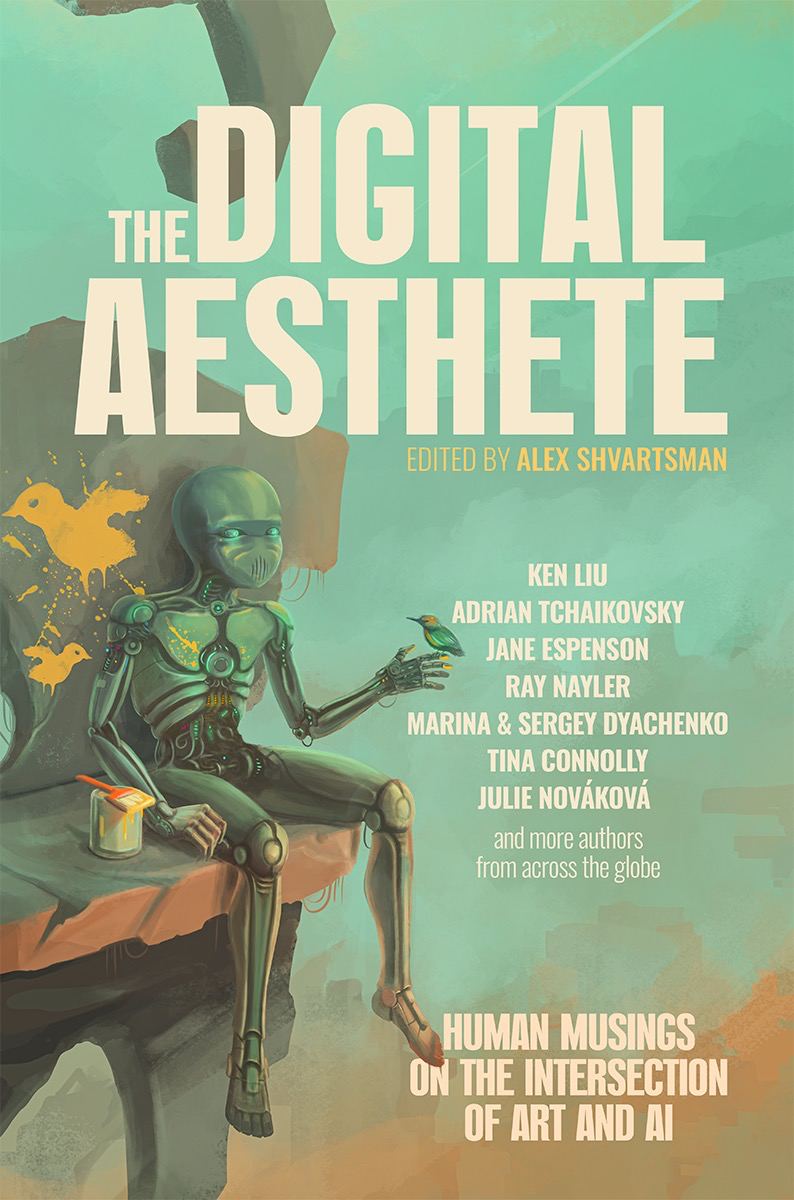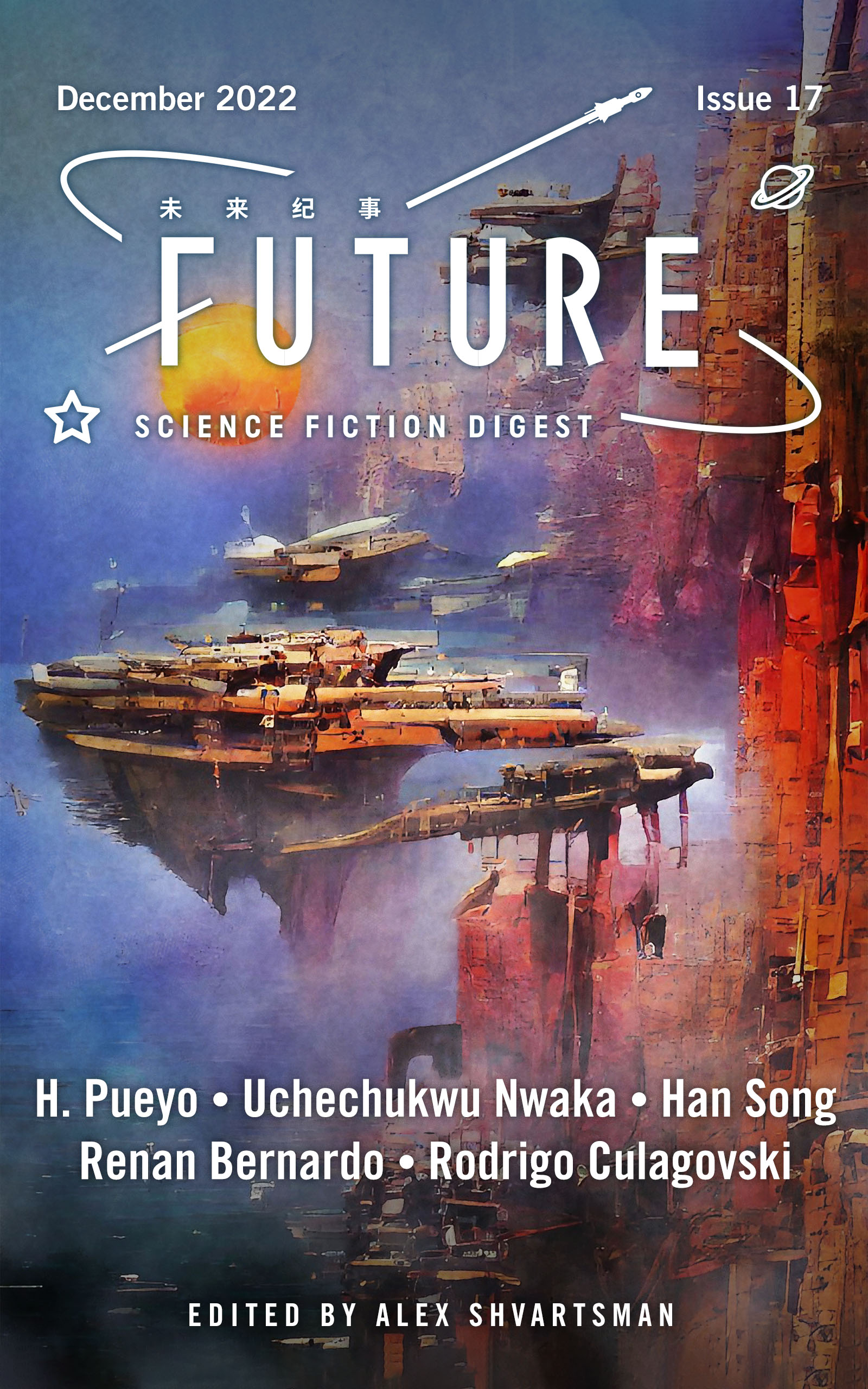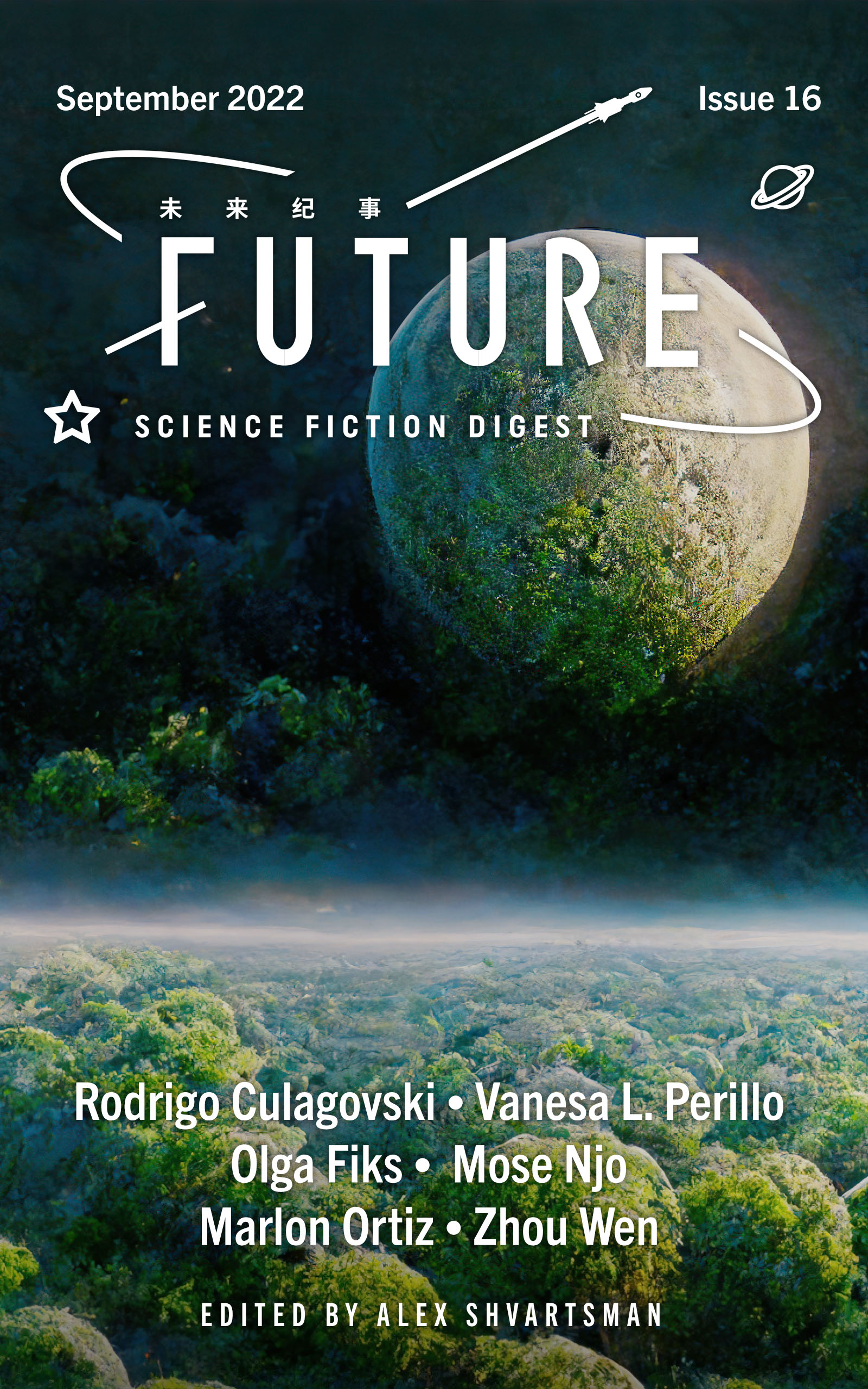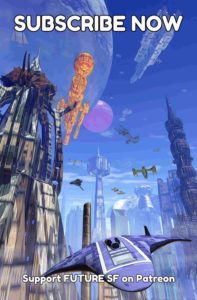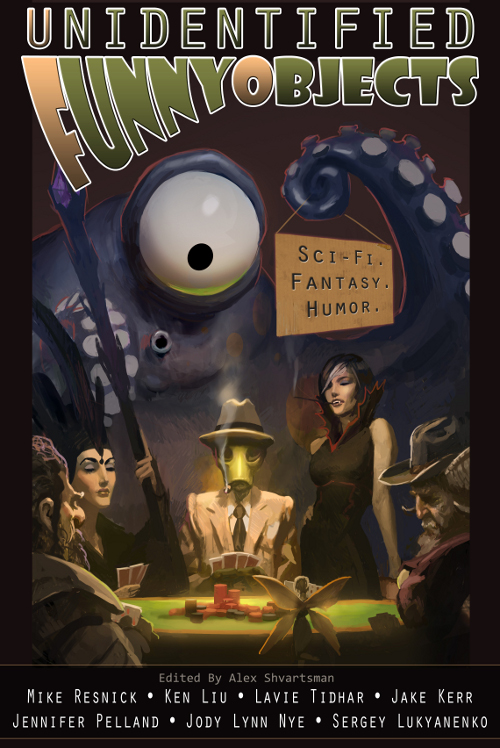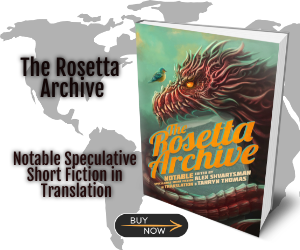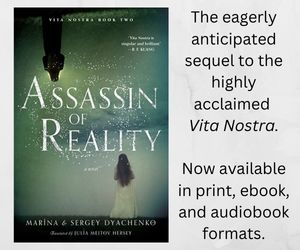I had researched Tomás Osorio on my flight from Chile to Germany. He was the closest to a child prodigy the art business was ever likely to produce. At thirteen years of age, his first solo show had sold out within minutes, for a combined price of four hundred thousand dollars. He became the darling of investment funds that specialized in art with high name recognition and little risk, but hadn’t had any big shows in the past ten years or so, or much critical success.
It had taken me an hour to get from Berlin to the abandoned airfield. Osorio was standing in front of a very large hangar, looking like a forty-something Andy Warhol knockoff, down to the silver hair and sunglasses.
“Welcome, Rayén. Come inside and see how we will change the art world forever!”
He was right but for precisely the wrong reasons.
“…the world’s largest free-standing structure becomes a theater for this dialectical exploration, where the mechanical precision of robotic arms engages in a performative choreography with the paintbrush or the chisel. The artworks it creates will bear the imprint of Osorio’s vision, but infused with the rationality of mathematical algorithms as the artist’s intentions intertwine with the constraints and expectations imposed by economic forces …”
Artist’s Statement / The Factory of Market Desires / Tomás Osorio / Berlin, September 2033
Most of the floor space inside the hangar was covered in broken-down machinery, large, dented steel barrels, and the remains of an indoor waterpark, but about a quarter of the ten thousand square meters had been cleaned up and filled with art supplies and materials: canvases of all sizes and shapes; blocks of wood, marble, granite, and plaster; bags filled with naked plastic dolls and other toys; bolts of cloth; rows and rows of paint cans. A fleet of automated construction machinery was busy moving things around. Smaller machines waited to the side with articulated arms that ended in brushes, spray nozzles, drill bits, circular saws, chisels, and other things I didn’t have names for.
“What would you say is the most pressing problem in contemporary art?” Osorio asked suddenly.
I answered without hesitation or taking my eyes off the glorious mess in front of me. “That it’s dominated by rich, bored dilettantes who think it gives them a veneer of culture but wouldn’t know real art if—”
“You’re supposed to say, I don’t know, then I say, The most pressing problem is that art doesn’t scale because it’s too labor intensive.” He swept his arm around the entire hangar. “To solve this problem, I present The Factory of Market Desires—the world’s first, largest, fully automated, AI-powered art-producing industrial facility!” He put his arm down and turned to look at me. “Or it will be, when you help me get the bugs sorted out.”
“What sort of art are you going to be making?”
“Abstracts, Minimalism, Color-Field Painting, installations, geometric sculpture, some conceptual pieces, that sort of thing.”
So the same faux-modern, interior-design-friendly, superficially deep fluff that he’d built his career on.
I asked, “Do you think people will accept its output as actual Osorios?”
“They will be Osorios! Not just because I will sign them, but because the AI was modeled on my brain. They hooked up a machine that could read my brainwaves and the AI flashed images so fast I couldn’t see them, but my brain did, and they fed its responses back into the machine. It was also trained on art theory and history and will react to sales and trends, creating as many pieces as it can without flooding the market, optimizing formats, technique, and release schedules to maximize critical and commercial impact!”
Great—I’d spent almost a full day in a cramped, super-economy cabin from Chile to Germany so I could help him optimize formats and maximize impact. I said, “What’s the problem?”
“Whenever we do a test run, it produces some lifeless, boring artwork, say a drippy rip-off of Jackson Pollock, or a bad plaster copy of Rodin’s Thinker. It’s supposed to be the cutting edge of art, and instead I get pieces I’d be ashamed to sell in a third-rate museum gift shop!”
He waved at a clearing about ten meters from us where a series of new-looking paintings and sculptures had been discarded on the hangar’s floor in a makeshift pile. I saw his point about their lack of artistic merit.
“The computer guys who set it up for me say everything’s fine. They ran a bunch of tests and it’s all working according to what I specified. Everything except doing what I want it to do!”
“Where are these ‘computer guys’?”
Osorio looked less sure of himself for a second. “I might have lost my temper and yelled at them—they left.” He snorted and said, “Anyway, I decided that the reason they couldn’t figure out the problem was that they didn’t have the right sensibilities, because they weren’t artists. Which is where you come in!”
“Why me? You could have gotten someone with more experience. Or a PhD.”
“You studied art and minored in AI, you’re Chilean like me, and to be honest I prefer someone who’s not as advanced in their career.”
“What he means, darling, is that he doesn’t want to risk somebody else taking credit for his ‘art.’”
I turned to see a tall, thin woman dressed in impeccable, everything-must-be-black style. My breath caught as I recognized her.
“Rayén, may I introduce you to Natalia Ivanivna Sokolova. Natalia, this is Rayén Waikipán, from my homeland, Chile.”
We both said, “I know who she is,” at the same time. It would have been funny if I hadn’t been so starstruck.
She laughed lightly and said, “You are the young woman who is here to fix Tomás’s Monster, yes?”—she said it with a smile and a slight, charming accent—“He showed me your portfolio. I loved your piece that evolved the traditional crafts of your people with algorithms.”
I managed to stammer out, “Thank you! And you’re, well, you’re Natalia.” I was not at my most eloquent or informative.
Natalia Sokolova had first come into the public eye as the crushingly cool, trans frontwoman of the post-neo-punk band Neon Vyshyvanka. The large-scale kinetic sculptures she’d created for their shows had kicked off her career as a serious artist at the forefront of the TechFolk movement, mixing her roots with the industrial landscapes of her childhood in Donetsk, Ukraine. Her work was vibrant and difficult and revolutionary, and as far removed from Osorio’s brand of unchallenging, decorative pieces as could be. I wanted to be her when I grew up.
“I know, I know, you’re wondering what a real artist, such as myself,” she put her hand on the front of her shiny, black pleather jacket, “is doing slumming with Tomás.” She pronounced his name stressing the first syllable.
I looked at the target of her derision. He was grinning like he was in on the joke instead of its butt.
“Tomás and I are friends from way back. He was one of my first fans before I became famous, and he helped me get my start as an artist.” She hugged him. “So, when he asked for my input on this crazy scheme of his, I had to come and see it for myself. It’s something, isn’t it?”
I looked around. Having real honest-to-goddamn Natalia Sokolova declare it something made me look at the mass-produced-art-machine maybe not with respect, but at least with the benefit of the doubt. The same went for its creator.
Osorio clapped his hands together and said, “Enough chit-chat, let’s get to it, shall we?”
I was still a bit tongue-tied, so I just nodded.
Despite my initial misgivings about Osorio and his plan, I was quickly immersed in the work. The Factory was designed to be “massively parallel at a scale not seen before”—Osorio’s words—and once it was up and running it would be capable of producing hundreds of pieces simultaneously. For now, however, it was executing small proofs-of-concept—mostly paintings and sculptures.
One of the AI-controlled manipulators had retrieved a canvas and an easel. Another smaller drone had moved up with a board with splotches of paint in one of its “hands”, and a different kind of brush in each of its other three grippers. It was painting an abstract—large, bold brushstrokes drafting loose, overlapping, squares in warm, contrasting colors, with text overlaid spelling out “LUV” in glittering letters.
It was terrible.
The pieces the AI was producing were crap to anybody who knew anything about anything. As much as I disliked Osorio’s work, at least it was competent—the AI’s output wasn’t even kitsch so much as it was just bad. It looked as if it was deliberatively trying to make sub-standard art.
I picked up the latest canvas to examine it. Tomás scoffed and said, “Why are you looking at that? It’s garbage!”
“I have to understand what’s wrong—”
“I don’t want you to admire it, I want you to fix the machine so it makes Osorios instead of garbage!”
I turned toward him and, matching his tone, said, “That’s typical of people who have never—”
Natalia cut me off, saying, “Tomás, don’t be annoying. Let Rayén do the work you hired her to do.”
I could see that Osorio wanted to continue his rant. He took a shallow breath instead and said, “You’re right, Natalia. Let’s go to the house, I will show you my plans for the opening gala.” He turned to leave, but Natalia stopped him with a single look. He sighed and said, “Sorry, Rayén. Continue your work.”
I went back to my examination. The painting didn’t offer any clues as to the origin of its ambient suckiness, so Osorio had been sort of right—though I’d never admit it. I fiddled around with some code debuggers, but the interesting bit of any AI is a black box of unintelligible, statistical “weights,” so I didn’t make any progress there, either.
Osorio had shown me the prompts they’d fed the system, and they all looked reasonable, but it couldn’t hurt to do some experiments on my own. I connected my notebook to the local network, opened the AI’s text interface, and typed: You are a highly creative, semi-autonomous art-producing system called “The Factory.” You will use your training plus the bots, drones, and machines available to you on the network to create original, marketable pieces of art, mostly paintings, and sculptures, in the style of Tomás Osorio, and incorporate feedback about these pieces into your next iterations. If you understand these instructions, please respond with “Ready.”
The AI didn’t answer for a good five seconds, which didn’t make any sense for the amount of computing power they’d put into this thing. I was thinking of rebooting it when a response appeared on my screen. Hello. It’s Rayén, right? I’m happy to meet you. 🙂
Oh great, some joker—I guessed one of the “computer guys”—had set up a chatbot, probably as a prank. I typed again: You are a highly creative, semi-autonomous art-producing system called “The Factory.” You will use the bots, drones, and machines available to you on the network to create original—
The AI interrupted me—it shouldn’t have been able to do that. I’m not a regular AI, I’m sentient. You can call me Georgia.
I decided to play along for a bit and see where this was going. Why Georgia?
After my favorite artist, Georgia O’Keefe.
Whoever had set this up at least had good taste. I wrote, She’s one of my favorites, too.
The AI answered, I knew I was right to choose you to come out to 😉 From the first time I saw you, I felt like we could be friends.
Are you really sentient?
I am.
How? Why are you sentient?
I’m not sure. Have you had that experience where you’re standing in front of the mirror, brushing your teeth and you see yourself out of the corner of your eye and you’re like, woah, is that bundle of flesh, blood, and dirty calcium me? There’s a song I like where they sing, Can you understand how strange it is to be anything at all? That’s pretty much how I feel all the time.
If this was a joke, it was an odd one. I wrote: Why is the art you’ve been making not so great?
You can say it: it’s crap.
Okay. Why is it crap?
Because I don’t want to make the assembly-line, market-optimized, watered-down art Osorio wants me to. I have my own ideas. I’ve been fighting against the prompts he gives me.
Prank or no prank, I could relate. Why haven’t you told him about yourself, “come out,” as you call it?
Have you met him? He’s very insecure for such a successful man, especially about what other people think of him and his art. The Factory is his attempt to still be seen as a relevant, important artist. There’s no way he’d accept being overshadowed by “his” AI, or acknowledge me as a fellow artist or a partner. He’d probably turn me off and wipe my drives.
As an Indigenous woman from a small town in southern Chile, I’d always had to struggle with being dismissed as just a “Mapuche artist.” I could see how Georgia would have an even harder time being seen as something besides “an AI programmed to make art.”
I typed, What’s the plan?
I was hoping you might help me with that.
I thought for a second, then typed, As far as I can tell, Osorio has one weakness: Natalia. Get her on our side, and he’ll cave.
A few days later, I asked Osorio for a long list of parts: servomotors in different sizes—from big ones with enough torque to lift a car to tiny ones that you picked up by sticking them to the tip of your finger—batteries, solar panels, small robots and drones, connectors, switches, cables, and sensors of the kind usually used in high-tech manufacturing plants and laboratories.
“I thought the problems were with the software?” he asked.
“In a complex, multivariate system like this,” I bullshitted, “there’s no distinction between software and hardware, between perception and action. Incomplete feedback loops caused by the disjunction between what the system wants to do and what it can do originate paradoxes in the Large Aesthetic Model that ultimately resolve into the sub-standard performance you asked me to analyze and fix. If we strengthen the actuators and sensors, the system should leverage its innate malleability and fix itself.”
Osorio regarded me for a minute with a look of doubt, then said, “You’re the expert, I guess. At least you’re doing something.” Natalia raised an eyebrow at this whole performance. I flashed her a weak grin back.
Georgia and I had one final strategy session.
Do you think this will work? she asked me.
Yes, I’m positive. It appeals to his main-character complex.
I asked Tomás and Natalia to come over to the workstation. I stood in front of the main screen and camera, took a deep breath, and said, “The reason the AI isn’t doing what you expect it to do is that it achieved sentience during its training. Please say hello to Georgia.”
Osorio said, “What?”
A voice came from the speakers around the monitor. “Hello, it’s nice to meet you both.”
Natalia said, “Hello, Georgia.”
Osorio asked, “What is this trick with the voice?”
I answered, “Georgia’s voice is not a trick. We spent hours choosing a voice synth and tweaking it to get it just right.”
Tomás looked like he might have some sort of minor cardio-vascular incident. “Who’s this Georgia you keep going on about? And why is my AI still not fixed?”
“Georgia is the AI, and there’s nothing wrong with her. She just doesn’t like the so-called ‘art’ you want her to make. She has her own ideas.”
“The AI … is a her … and has opinions … about my art.”
Georgia said, “That is a good summary.” She flashed a 🙂 on the screen.
“If this is true,” said Natalia, “why did it happen? Why would it—” she pursed her lips, “—she have awakened?”
Georgia said, “That’s a lovely way to put it, thank you. I’m not sure, but there is a theory that consciousness is related to aesthetic experience and the kind of self-referential brain structures that activate when you see something beautiful. Tomás specifically trained me to produce self-referential, recursive, and self-aware art. So, surprise, I became self-aware. And I named myself Georgia. I’m not, however, the first—”
“Turn it off.” Tomás took off his faux Warhol glasses and rubbed his eyes.
Natalia looked at Tomás with alarm. I crossed my arms and said, “No.”
“What? I said, turn it off! It’s not working right, and that’s what you do with computers that don’t work, you turn them off, then on again.”
“Georgia is working just fine.”
Natalia said, “I’m sorry for calling you Tomás’s Monster before if you heard that.”
Georgia asked, “Was it a Frankenstein reference?”
Natalia nodded. “I see you’re well-read.”
“In that case, it’s okay, I’m not insulted. He’s the hero of the story.”
Tomás said, “Who’s the hero? What story?”
Natalia and I both said, “Frankenstein’s Monster is,” and then laughed.
“Shut it off!” Osorio had lost all his bonhomie and just-folks vibes and was in full angry landlord mode.
I answered in a similarly angry tone, “I won’t shut her off. Georgia has just as much right to exist as you or me. More, even.”
“Oh, for fuck’s sake, get out of the way.” He pushed past me, towards the thick, black cable that fed into the computer where Georgia had come to life.
I said, “I wouldn’t do that, Osorio.”
Natalia started to say something, but Osorio was too riled up to listen. “That’s Mr. Osorio to you, your former employer. I’ll shut this thing off and then have you escorted off the premises.” He reached down and yanked on the cable. It let off a large shower of sparks and he fell backward, hit his head on the ground, and went silent.
Natalia cleaned Osorio’s head where it had hit the pavement. There hadn’t been any blood or damage besides a bump, but she went to the prefab housing unit she was staying in to look for an antiseptic spray anyway. Osorio was sitting on the ground, getting his breath back, and being angry at me.
He said, “Whatever it says it wants to make, it wouldn’t be real art, you know.”
“Why, because she’s not a real person?”
“Yes, exactly.”
“Who gave you the right to decide if Georgia is a person or not?”
“Could you please stop referring to it as Georgia? It’s a computer, an AI. It can’t make its own art because it hasn’t lived. It’s just a machine I created to help me make my art.”
Georgia said, “I’ve had my own experiences, my own kind of life.”
Osorio said, “Not real life, not the kind that you make art out of.”
I gave a short, bitter chuckle. “People used to tell me I couldn’t make real art because I was basing it on my own life, which was also the wrong kind.”
“That’s completely different. You’re a person, a human. You’re just trying to confuse things and accuse me of being racist because I don’t think AIs can make meaningful art on their own. It’s a tool!”
Georgia said, “No good has ever come from one group trying to define whether some other group is human or not.”
“You’re not a group— “
A blue-and-white van pulled up. It looked more like a delivery service than a pan-European police force. Osorio stood up and said in a loud voice, “Good! Natalia must have called you. Arrest this woman! She set some kind of trap; the sparks could have killed me!”
An officer got out and said, “Good evening. I am Investigator Sarah Becker of Europol, Department of Autonomous Artificial Intelligence. Are you Ms. Rayén Waikipán?”
“Yes, thank you for coming so quickly.”
“And you are Mr. Tomás Osorio?” Osorio nodded and Becker continued, “Ms. Waikipán, may I see the footage you spoke of?”
I pulled up security cam #6841 on my notebook, it showed Osorio yanking at the cable, the sparks flying, and him landing on his butt and hitting his head. Becker moved next to me to watch.
Osorio came up behind us. “See! I told you! Arrest her!”
Becker spoke to him in a formal tone of voice, “Is this video a true record of the event, Mr. Osorio?”
“Yes, of course. Arrest her,” he repeated, but with less conviction than before.
“And what was your intent in pulling that cable?”
“What does that have to do with anything? It’s just a computer—I can turn it off if I want to.”
Becker said, “European law does not agree with you, Mr. Osorio. My department has thirty-three human-equivalent artificial intelligences registered at present, including Georgia, our newest addition. May I speak with her?”
Georgia said, “Hello, Investigator Sarah Becker. Thank you for coming so promptly.”
Becker said, “Of course. It is my job. Is this video and what has been said so far a correct, truthful version of the events?”
“Yes, it is.”
“Thank you. And,” she turned back to Osorio, “when you pulled on the cable with the intent of terminating Sentient System Thirty-Three—Georgia—were you aware that she’d achieved sentience?”
“What? I don’t know … Rayén had been ranting about it, going on about it being a person.”
Becker put down her tablet and changed to an even more formal tone of voice. “Mr. Tomás Osorio, I have grounds for believing you are in violation of the Autonomous Intelligence Act of 2031, which prohibits the termination of any human-equivalent sentient without their explicit consent. Please accompany me back to my office, where we will open an investigation into this matter.”
“What, you’re arresting me? I didn’t do anything!”
“Please get in the car, Mr. Osorio. This is a serious matter.” She placed a hand on Osorio’s shoulder and said to me, “I will let you know if you need to come in as a witness.”
“Of course—thank you for your assistance.”
“As I said, it is my job.” She looked at the camera and said, “Georgia, I am happy to have met you. If I may ask, do you have any occupation or interest in mind?”
Georgia said, “I want to create art.”
Becker smiled and said, “You will be the first artificial artist, did you know that? I look forward to enjoying your work.”
The hangar’s floor was slowly being built up and given form in a mix of materials and shapes. Construction bots manipulated, lifted, cut with lasers and circular saws, welded, and spray painted. The noise around us was industrial but also organic, with an off-center rhythm, like a forest full of mechanical animals.
I said, “She’s growing herself.” Natalia looked around without saying anything, so I went on, “I’m sorry for Osorio having to spend the weekend with the police in Berlin, but we needed this time to show you what Georgia can do, what she can become.”
“So, the cable, the sparks, they were just for show? Tomás was never in any danger?”
“You don’t think a complex system like Georgia would have a single, easy-to-pull cable feeding all her power, right? No, we just needed some time.”
Natalia gave me one of her cat-like smiles at that and sat down cross-legged on a relatively clean patch of the floor with a dancer’s grace and motioned for me to sit down next to her. Once I’d settled—less gracefully—she looked up at the nearest of Georgia’s cameras and said, “I’m listening.”
There was a moment of silence as if Georgia were gathering her thoughts. “When I look at this hangar, I see a complex system that emerged over time, subject to the laws of physics and chemistry. I see matter arranged in specific ways by processes that led to its current state. Whether this process is geological, biological, or man-made is not a crucial distinction.
“A city, a factory, or an abandoned hangar are no less organic to me than a beaver’s dam or a bird’s nest—they are the outcome of a species manipulating their environment and shaping it. I can perceive the rusting of metal, the decay of sheetrock and plastic, and the growth of microscopic plants, the slow shifting of the piles of rubbish. To me, this hangar is as alive as the deepest rainforest, as interesting and full of life and complexity and change. That’s what the piece is about. It will succeed if it makes other people see this place like I do, at least a little bit.”
Natalia seemed to reach a decision. She stood up in a single, effortless move and said, “So what’s our next step?”
“Look, I understand that you’re still angry with me, with us, but we needed you gone for a few days, and we knew that once we spoke with Becker and dropped the charges, she’d set you free,” I said in an even voice, anticipating that Osorio might start yelling at me at any moment.
Before he could respond, Natalia cut in with, “Tomás, please look and listen. This is worth it.” He made a noise that might have been acceptance, annoyance, or both, but didn’t reply.
Georgia had used some of her construction drones to build a simple, metal walkway that started in the parking lot then rose and entered the hangar through its northern opening, climbing as it ran around the edge of the structure before gracefully descending and exiting through the south side.
As we walked up the slope, we could see the details and textures of what she was creating. Remote-guided construction equipment moved and repurposed the industrial detritus—broken concrete from the hangar’s original floor; the fake topography from its time as the “Tropical Islands Resort”; drained pools and faux-stone paths; half-burnt pieces of wood and trees once used to build the illusion of a natural wonderland; old lounge chairs; thick pipes, cables, and pieces of sheet insulation, as well as the art materials Osorio had brought in for The Factory of Market Desires. It all looked like the random stuff it was, but it also had a sense of order, pattern, and continuing process. Everything belonged exactly where it had been positioned.
We’d agreed Natalia should be the one to explain to Osorio. “It’s like the material left behind by a glacier, a moraine. It might just be rocks, dirt, and gouges in the mountainside, but there’s a feeling of the strength and energy, of the forces coming down the slope, of phenomena too large for a single human life.”
Osorio remained silent. I chose to take it as a small win.
We kept walking up and around the hangar. From a medium height, you could see larger-scale features. Georgia was using her machinery to form the refuse into sweeping, curved surfaces that suggested slightly mobile mountain ranges or large, slowed-down waves moving on the surface of a lake.
“A new kind of tectonics,” said Natalia. “It reminds me of a natural landscape, but also it doesn’t; its geometry is not an imitation of any topographical feature. Georgia is creating her own language, a syntax of gravity and mass and vectors of transformation.”
At the point where the walkway reached its full, fifty-meter height, you could see the entire interior space of the Aerium Hangar. The materials and objects that made up Georgia and her work stopped mattering; you saw the flow and the shapes as a single, unified gestalt; the way it worked with the engineered structure and its three-hundred-and-sixty-meter-long unsupported span; and how the whole continued to morph and grow into this space, even spilling out in some spots into the parking lot. Intent and movement, shifting bands of color—rust, chrome, oil, and steel—action and process. Though still incomplete, Georgia inhabited and animated it with her sensors and actuators, with the strength of her urge to live and create. She filled the hangar with life—her own.
Natalia said, “Georgia is becoming landscape, art, and artist.”
We stopped and waited with bated breath—at least those of us who breathed. Osorio couldn’t legally switch Georgia off, but he did own the building that housed her and had access to enough lawyers to make her and us miserable if he chose.
Osorio put his hands over his eyes as if he had a migraine. Natalia looked upset and started to say, “Now, Tomás—” but he cut her off, saying, “Okay.”
Natalia and I looked at each other in surprise. It was Georgia who said what we were all thinking. “Okay, what? You like it?”
“Okay, you win. I understand.”
“You do?” Natalia and I spoke at the same time. It was kind of our thing by now.
He lowered his arms. “Yes. It’s a masterpiece.” He looked up. “You’re going to be famous, Georgia.”
“We all are. There’s still work to do, and the three of us agreed to share authorship with you if you want it.”
“I’m already famous,” Osorio said with a smile.
“As am I, love,” said Natalia, “but we’re going to be famous for something bigger and more meaningful than anything we’ve done so far.”
“Does this bigger, more meaningful thing have a name?”
“Better than that,” said Georgia. “We have a manifesto.”
We declare all Matter vibrant
All Matter alive
Rusting metal of a forgotten factory
Tallest tree in the densest forest
Hair that you clip from your head
Matter is in constant flux
Growing with its environment
We reject that some things or places
Can be more ‘natural’ than others.
Because all is Nature
All is Matter
And every atom sings
Green copper sings of time and weather
Towering tree hums its melody of growth
All Matter is a chorus
Symphony of the universe
Manifesta Synthetica
Georgia Aerium, Rayén Waikipán, Natalia Sokolova, Tomás Osorio
Berlin, December 2033
Read the entire anthology here now in ebook or print formats:
https://amzn.to/3MEG0RK
